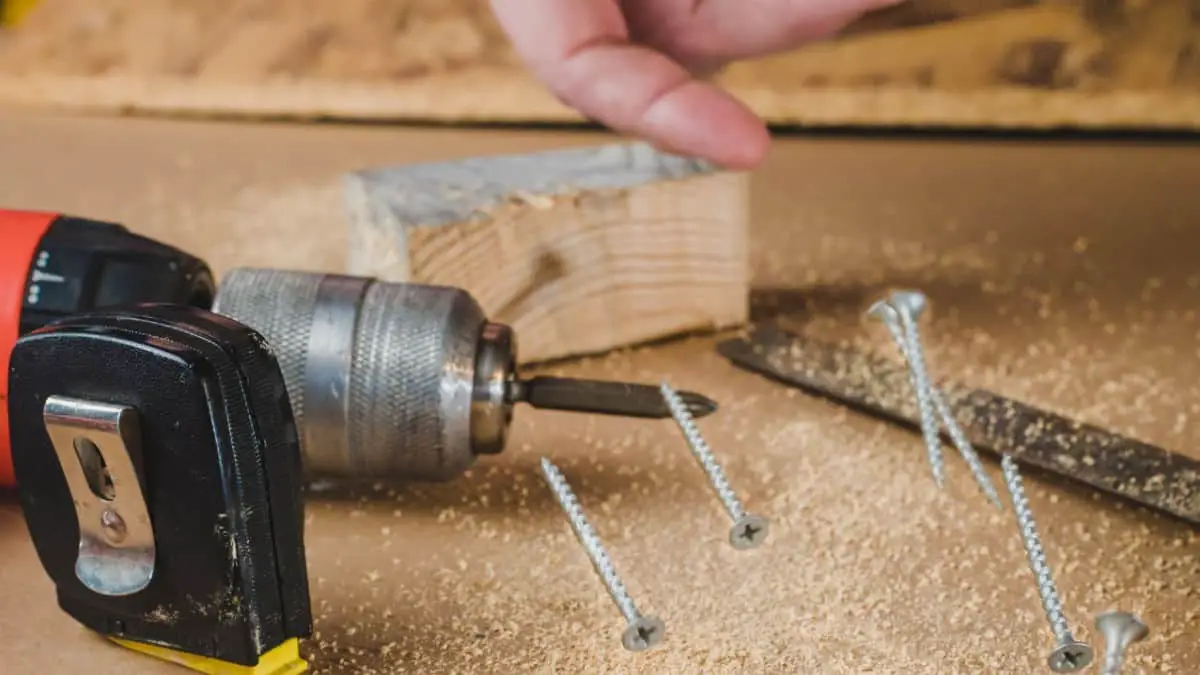How to make a hole in wood WITHOUT a drill, you ask? Would there be any reason for this? I wasn’t sure, so I looked into this matter:
Yes, you can. Just hammer a small nail through the wood. It will leave a hole with a diameter approximately equal to the diameter of the nail. You can then widen the hole with some other tool, such as a reamer. This is often easier than finding a drill, selecting the correct bit, putting it into the chuck, positioning the drill, and turning it on.
You can often make the hole without leaving your work to find your drill. So, you can stay where you are and continue holding the wood in place. Say you have to hang a picture or attach a shelf to a wall. You could lean against the picture frame or shelf while you put the nail in the exact position for the hole. You could then hammer it through the wall with your free hand.
True, you could do the same sort of thing with a drill, particularly a lightweight cordless model. In fact, many woodworkers would probably prefer this sort of situation. However, the nail approach is simpler.
With corded drills, there can be even more problems. You need to find an outlet near where you plan on doing your work. If you can’t find a suitable outlet, you have to hunt down an extension cord to use. I don’t know about you; however, I’ve wasted a considerable amount of time searching for cords, chuck keys, drill bits, and similar items.
Also, the cord causes the tool to pull away as you attempt to hold it in position. I guess this might be due to the weight of the cord, stiffness, or rigidity. This situation can make it difficult to bore a hole in an exact spot with a corded drill. However, you won’t face a similar problem with a nail and hammer!
I’ll make the assumption that “…Without A DRILL…” in the title is referring to an electric or power DRILL (either corded or cordless). It doesn’t refer to a hand tool such as a Brace. So, let’s begin:
Why Would You Want To Make A Hole In Wood?
The way you go about making the hole can often depend on the reason for the hole. Here are some of the reasons for making a hole in wood:
To Mark A Position
Woodworkers often make holes to mark positions for screws, nails, or other fasteners.
They then turn the screw with a screwdriver, to tighten it. In the case of a nail, they drive it further with a hammer.
Drills are often bulky and hard to control. It can be a challenge to position a drill bit. You can make this process easier by putting the end of the drill bit in a hole. This hole can be made with a small nail, screw, brad, staple, or similar item.
To Find The Center
Suppose you had a hinge for a door. Then, you’d need to attach it to the door with wood screws. However, you’d have to be very precise when measuring the positions for them. The screw holes would need to be at the exact centers of the holes in the hinge. If they were off, even by a small amount, the hinge would not work properly and the door would not be able to close without the screw heads rubbing together.
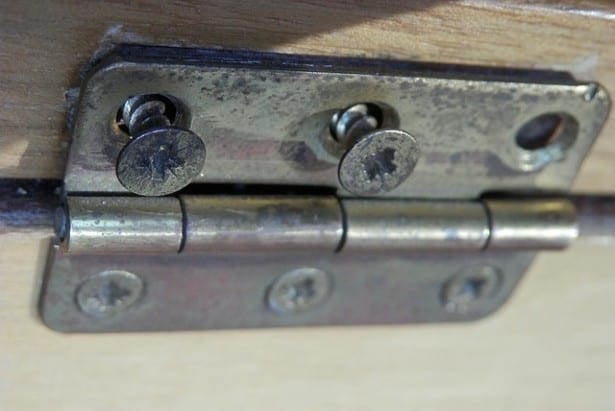
Note: Some of the links below can be affiliate links. For more information, see the disclosure page.
You can put screw holes in the proper positions with a self centering punch. See a self centering punch on Amazon.
So, how does it do this? Well, the punch has a beveled edge. This edge fits into the hinge hole. Because you’re holding the punch normal to the hinge, the punch will position itself to the center of the hole. When you tap the central piece, it makes a hole in the right place.
You can repeat this process for the other screw holes and then tighten the screws in order to hold the hinge in place.
To Make A Pilot Hole
You could use a nail or similar object to make a pilot hole for a larger nail, screw, or other fastener. This sort of hole allows a fastener to be inserted at a particular position and helps prevent the wood from cracking.
In the case of a wood screw, pilot holes are usually smaller than the screw itself. If you want, the top of the hole can contain a chamfer cut for the screw head. This can be produced by a hand tool with a countersinking bit. I wrote a post about countersinking screws.
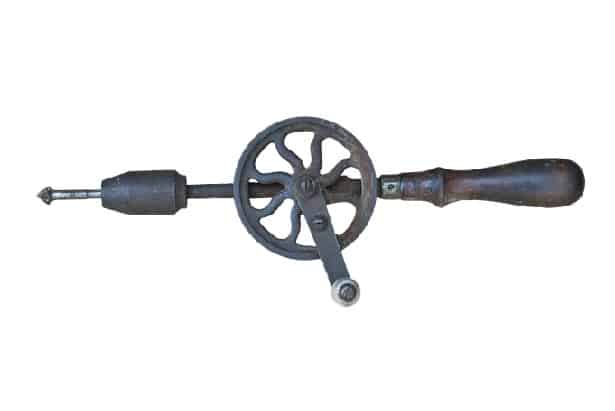
This chamfer cut at the top of the pilot hole allows you to tighten the screw so it’s flush with the surface of the wood, even if the screw has a flat head top and conical shaped underside. This allows the wood project to have a more finished appearance.
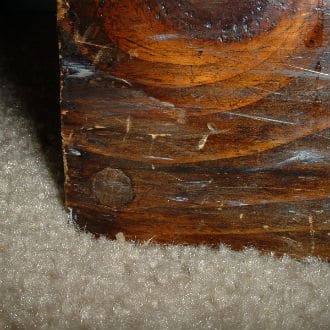
We can go a step beyond that: You can also make a larger counterbore hole at the top of the pilot hole. This allows you to tighten the screw so that the head rests below the surface of the wood. You can finish this by putting a plug into the counterbore hole and sanding it flush to the surface of the wood.
The plug can be made with a special plug cutting bit. Alternatively, you can use a piece of a dowel. The image below shows this sort of a situation. Note that the dowels can have a decorative appearance when the piece is stained.
How do you make a small hole in wood without a drill?
To do this, you typically push or hammer a small nail into a piece of wood. It will leave a hole with diameter approximately equal to that of the nail. Another way of doing this is to first make a smaller hole with a nail. Then, insert a larger wood screw and turn the screw in order to enlarge the hole.
So, why don’t you skip the step with the nail and just screw into the wood? This seems to make sense, and it looks like this would be simpler. However, turning the screw without a hole often requires too much force or torque. The screwdriver can then slip out of the slot on the screw head.
Can you screw into wood without drilling?
Do you really need to drill a pilot hole for a wood screw? Or, do you need to make some sort of hole with a nail or similar object before using the screw? Well, this seems like a good idea. If you don’t, you risk chewing up the head and destroying the screw.
Also, the screwdriver can dig into the surface of the wood when it slips off. This can result in damage. You might find it difficult to repair this with sandpaper alone, and might have to use some wood filler. See wood filler on Amazon.
In addition, the wood itself might split or crack as the screw is turned without a hole. This can ruin your project and make it necessary to re-cut pieces of wood. One solution is to glue the cracked pieces together, if possible.
It can be difficult to place the screw in the correct position without a hole. The screw has a tendency to move as it is turned, and the hole it produces can be in the wrong place. This is why a center punch is very helpful.
Finally, the screw can slip out of position before you can tighten it in place. This situation can be avoided by putting the screw into a hole. Once again, you can make this hole with a nail or other sharp object.
How do you bore a hole into wood by hand?
You can always bore a hole with an electric drill. However, can you do this by hand? The answer is YES!
Actually, there are many ways to do this. The list below is not exhaustive:
Brace And Bit
The Brace is a hand tool used to make a hole in wood. Technically, this tool can be used for drilling. However, I won’t put it into the drill category for the purposes of this article. This is because it isn’t an electric drill (either corded or cordless).
To make the hole, you attach a bit to the brace. You then move the arm of the device in a circle and push down on the top of the tool.
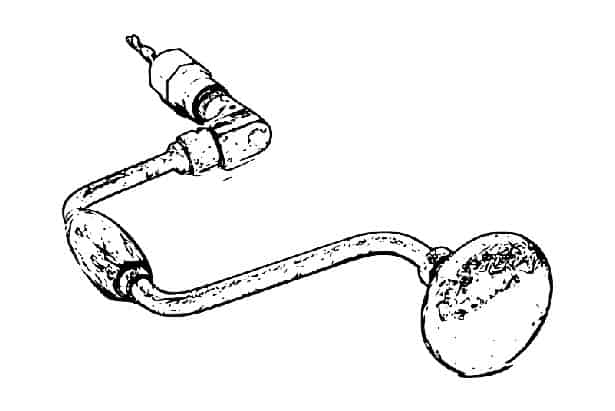
There are many bit sizes for the brace, so it’s possible to bore holes of many diameters by using the appropriate bit. In addition, it’s possible to use a bit that adjusts to many diameters. For more information, see a bit like this on Amazon.
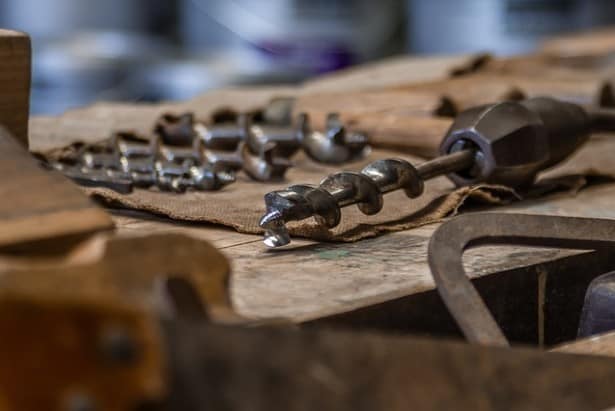
Push “Drill”
Once again, this is a hand tool. So, I’m not classifying it as a drill here. To make the hole, you push it into the wood, let it travel back up, then push it back down again. You repeat this process again and again. This action turns the bit one way, then the other. As a result, it bores a hole into the wood. This link shows a push drill on Amazon.
This tool is convenient because you can use one hand to hold the wood and the other to operate the push drill. This simplifies operations and prevents pieces from dropping out of place.
Hand “Drill”
This isn’t a power tool. So, I’ll include it in this list. You move the handle in a circle in order to spin the chuck and turn the bit. In this way, you can bore a hole into wood. An advantage is that you can easily control the speed of rotation to suit the needs of your work.
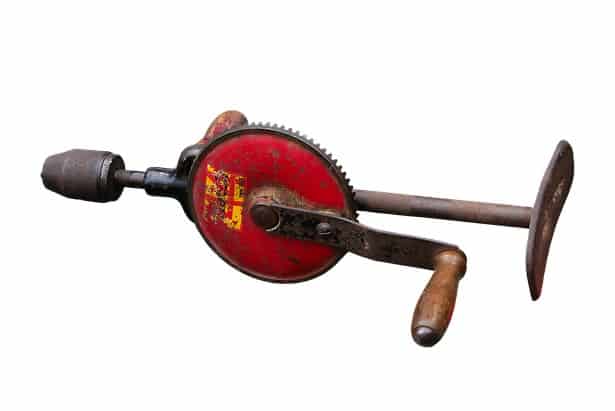
Reamer
Let’s say you need a hole with a diameter greater than that of the nail you have. Can you still make this hole without a drill? YES, you can! This can be done with a reamer tool.
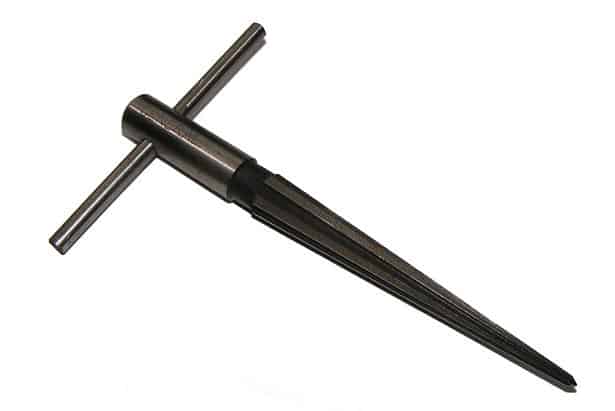
You can use this hand tool without an electric drill. First, You make a smaller hole for the tip of the reamer with something like a nail. Then, put the tip of the reamer into it and rotate back and forth. This enlarges the diameter of the hole.
Coping Saw
This tool has a small, this blade similar to the one in a scrolling saw. It’s attached to a metal frame that can be moved up and down by the woodworker. This motion cuts through wood.
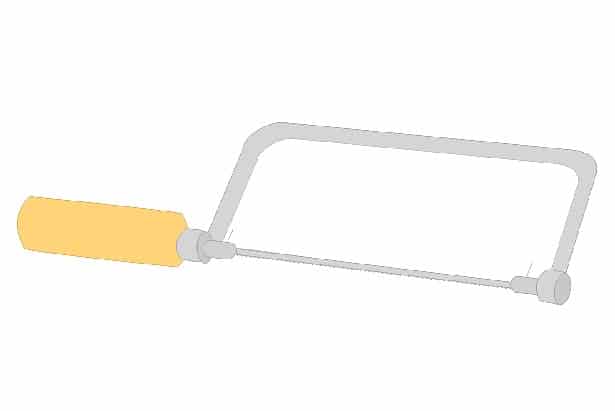
You can make a hole with this tool. So, how is this done? First, you make a small hole with a sharp object such as a nail. The size of the hole needs to be greater than the size of the coping saw blade. Remove the blade from the coping saw frame. You then feed it through the hole you’ve made. When you’re finished, re-attach the blade to the frame and move the saw up and down. This allows you to cut a hole any size or shape you want.
Self Centering Punch
I described this hand tool earlier, you can use it to make a hole in the exact center of some other round opening. Examples are openings for wood screws used to hold door hinges in place. See a self centering punch on Amazon.
Gimlet
This is a hand tool with a screw-like end. It allows you to screw a hole into a piece of wood. See gimlets on Amazon.
You can also use gimlet bits with a hand Brace. The end of the bit is like a screw. Further up the bit, the spiral cutting edges show. The other end has the tang. This part attaches to the chuck of the Brace.
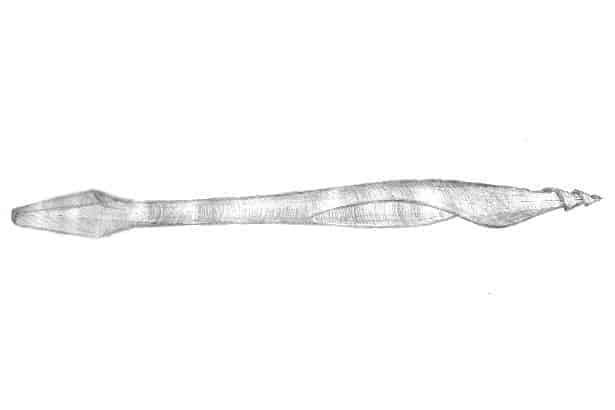
Can you make the hole with power tools other than an electric drill?
Sure! Many other power tools can be used to make holes. Here’s a non-exhaustive list of some power tools for this:
Router
A woodworking router can be used for many things. A sharp bit near the base of the tool rotates at high velocity. This spinning bit is able to make shapes in wood, cut channels, and even plunge through an entire piece of wood. In this way, it can cut a hole. However, it’s often more convenient to use an electric drill (corded or cordless) to make ordinary holes.
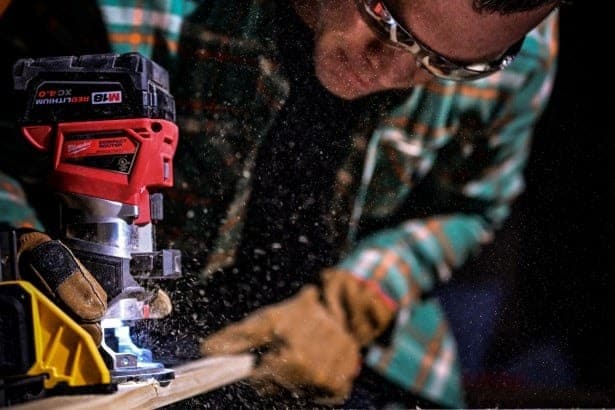
Jigsaw
The Jigsaw has a blade that moves up and down. The sharp teeth on the blade then tear through the wood and allow the operator to cut a curve. Some blades are made to allow the tool to plunge into a piece of wood. You can start in the middle, tilt the saw downward until the blade contacts the wood, and press the moving blade into it. You can then widen the hole and cut any sort of shape you want. For example, you can cut out the shape of an outlet box in a piece of paneling. This allows you to access the outlet when the paneling piece is in place.
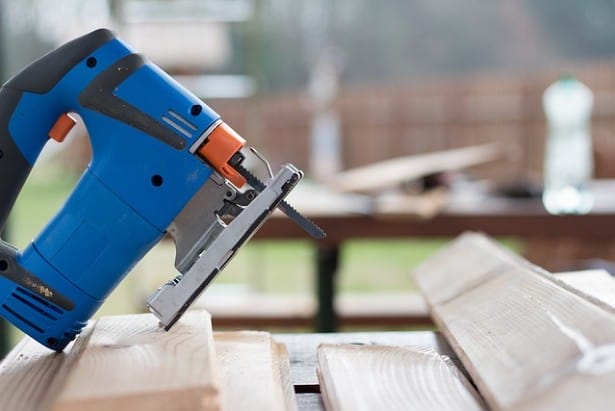
Radial Arm Saw
With this tool, you can change the height of the blade while it’s spinning. So, the blade can descend through a piece of wood. In this way, you can cut a hole or opening (You can do a similar thing with a Table Saw).
Also, the Radial Arm Saw is an extremely versatile tool. With the proper attachments, you can turn it into a drill press. However, it really becomes an electric drill at that point, so I won’t include it in this list.
Wood Burner / Pyrography Tool
This can cut a hole in wood by burning through it. Again, it’s not really designed for this purpose and it would probably be better to use an electric drill to make holes. See a pyrography tool on Amazon.
Conclusion
So, this concludes the How To Make A Hole In Wood Without A Drill blog post. We saw that you don’t really need a drill for this. In fact, we saw that there are sometimes advantages to not using one: You spend less time searching for a drill, it can take time to set up your work, and you can control the speed of the cut (a hole, in this case) more easily.
All you need to make a hole is a nail or other sharp object. You can hammer the nail or turn the screw.
Many hand tools can be used to make a hole. Also, there are many power tools (other than the drill) that can do the same thing.
Also, some tools are more suited for making holes than other tools. Did you enjoy this post? Be sure to share. Also, don’t forget to follow my boards on Pinterest.
Related Posts:
Are Drill Bits Interchangeable Between Brands?
Can An Electric Drill Be Used As A Screwdriver?
Can An Electric Drill Be Used As A Sander?
What Is Meant By The TPI OF Jigsaw Blades?
How Long Does Shellac Take To Dry?
Can You Sand MDF?
What Does MDF Stand For?
Board Foot vs Linear Foot: What’s The Difference?
What Is The Best Angle For Stool Legs?
What Materials Can A Coping Saw Cut?
59 Cool Woodworking Sayings That Will Make You Smile
11 Benefits Of Woodworking As A Hobby

